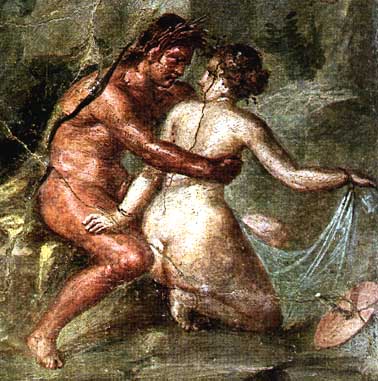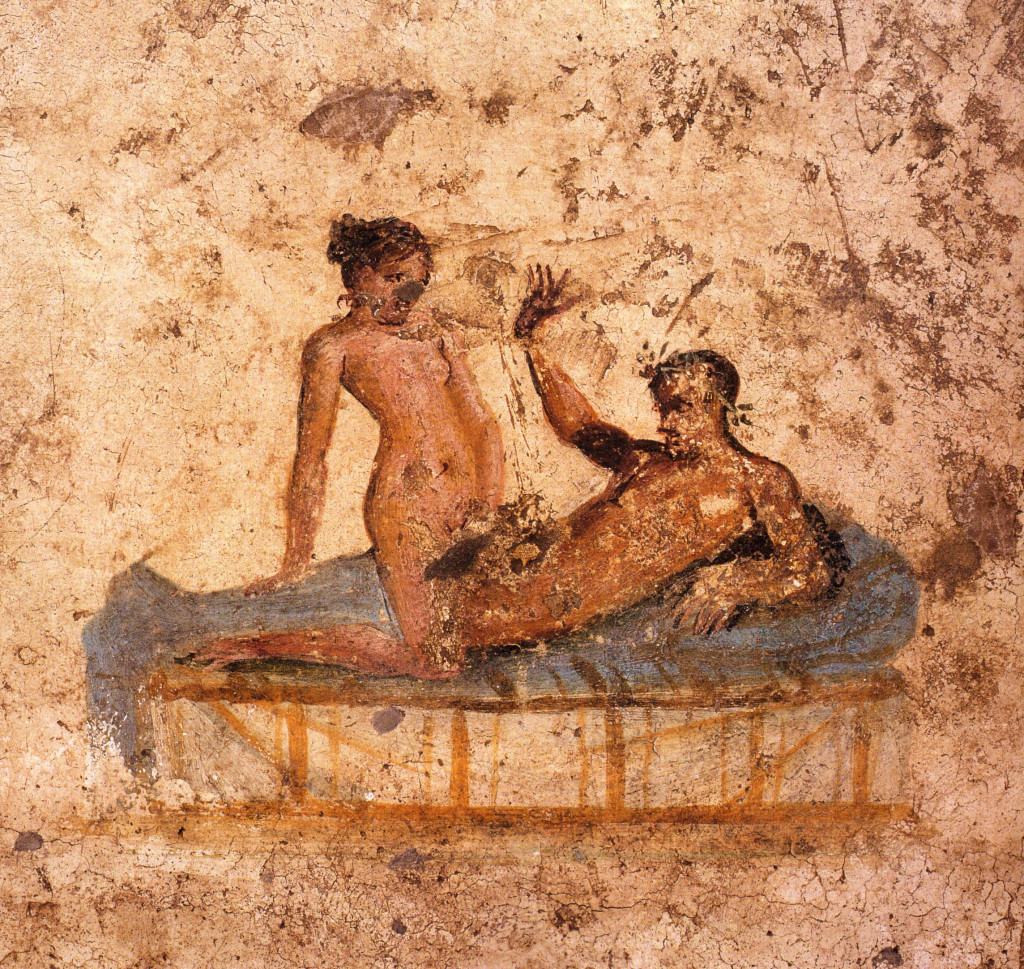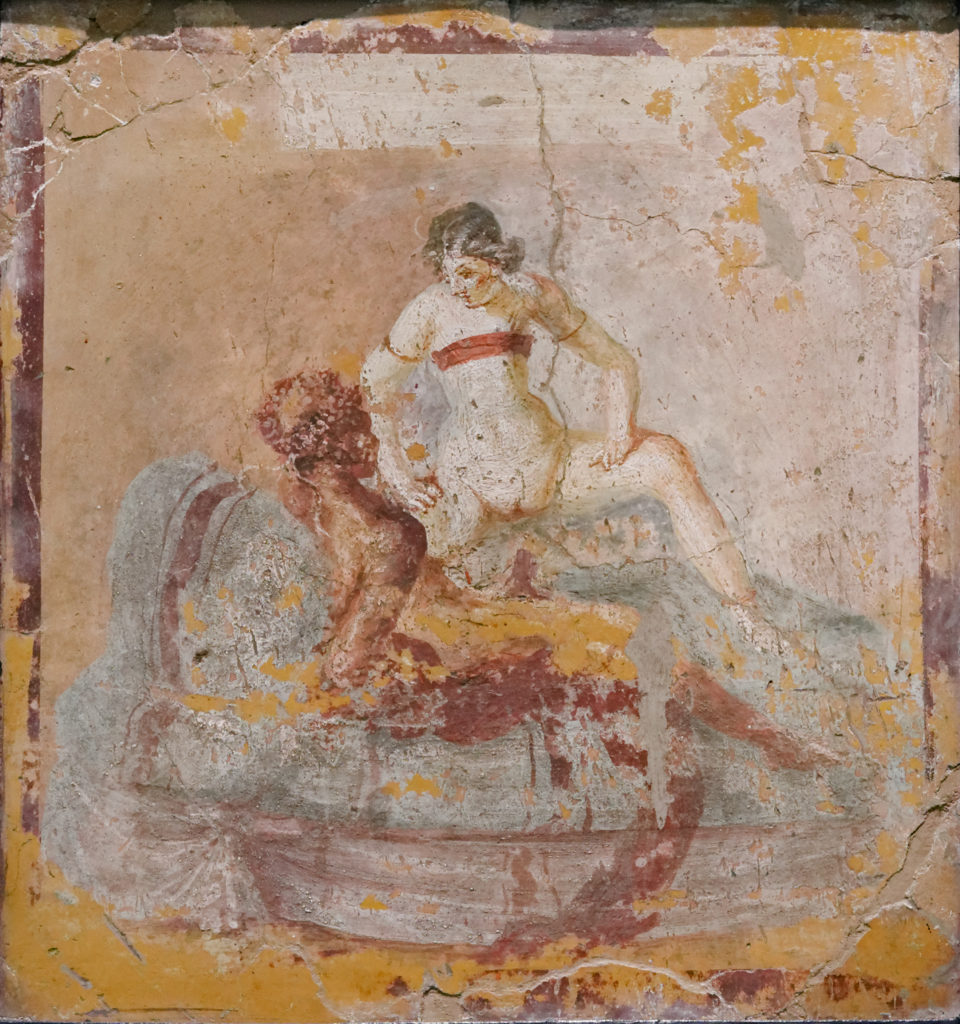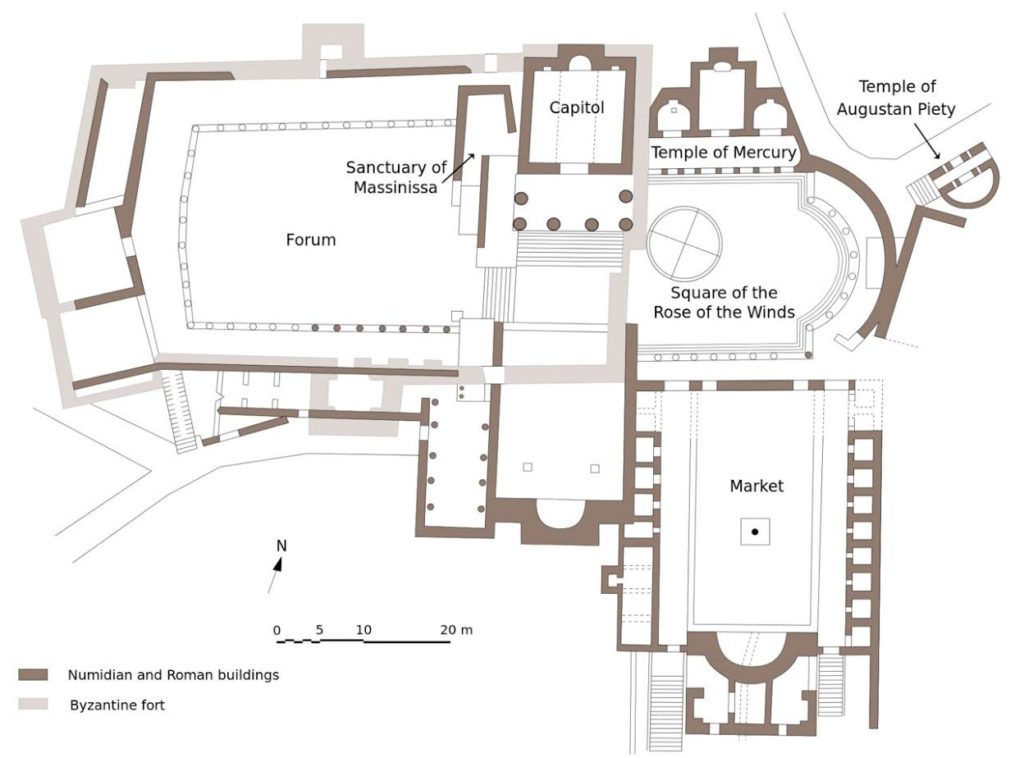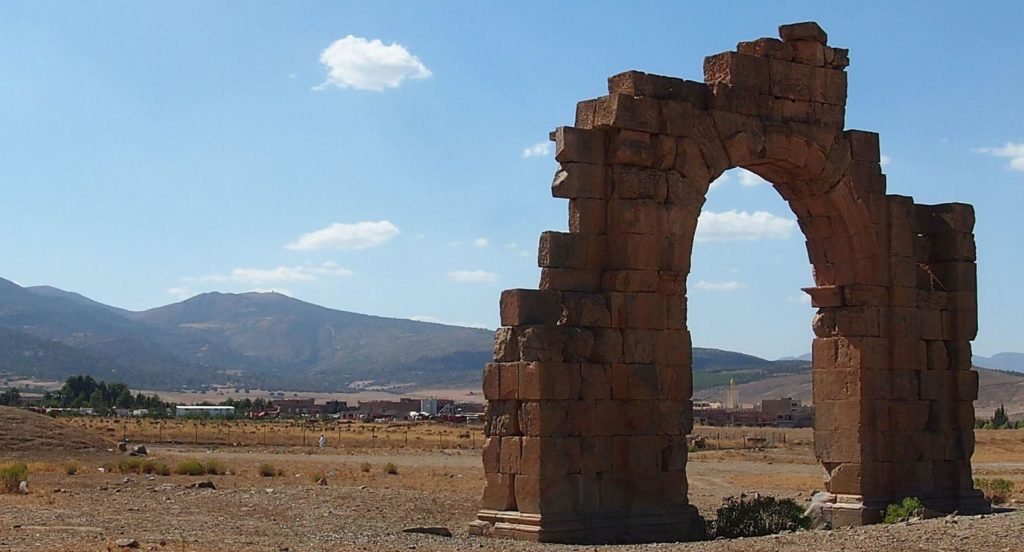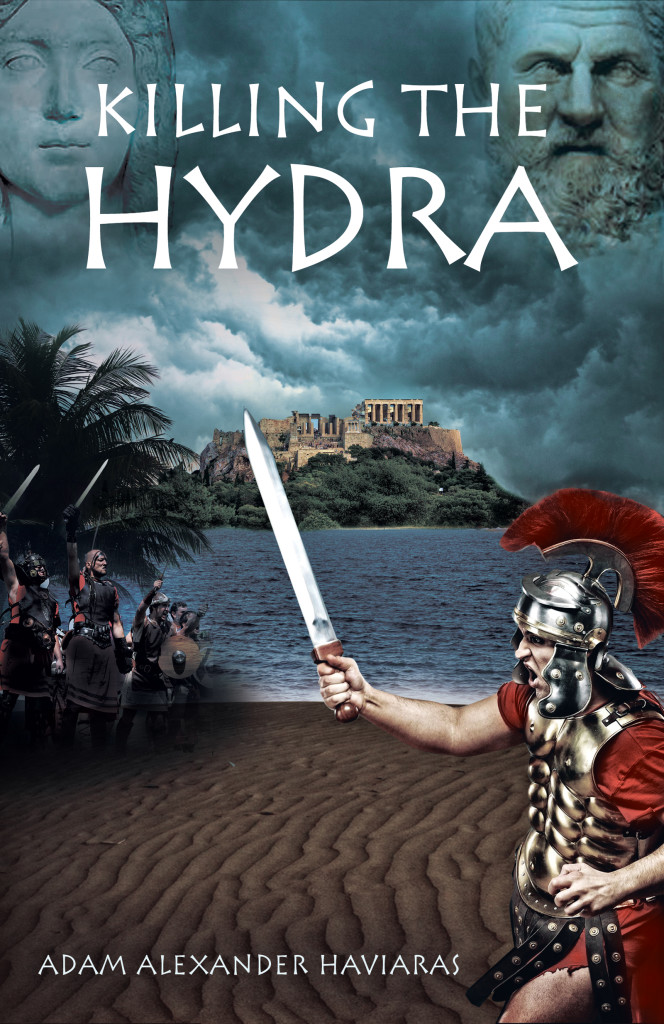
Part I – Leptis Magna: The Jewel of Roman North Africa
As with The World of Children of Apollo, this blog series will take a look at many of the people and places that the series protagonist, Lucius Metellus Anguis, encounters throughout his journey.
So, let’s step back in time to the early 3rd century A.D., and explore the first place Lucius comes to in Book II.
The ruins of Leptis Magna are located at what is now Khoms, a site by the Mediterranean Sea at the northwestern corner of Libya. As a Roman city and archaeological site, it is not really familiar to the average person. Mainly academics have studied it, and excavated its wealth of cultural treasures.

Aerial view of Leptis Magna
It was founded around 1000 B.C. by Berbers and Phoenicians. Later, Carthage held sway over the polis until that great civilization finally succumbed to the Roman war machine at the end of the Third Punic War in 146 B.C.
It was during the reign of Emperor Tiberius (A.D. 14-37) that the city was officially incorporated into the Empire’s province of Africa Proconsularis. In A.D. 110, the Emperor Trajan (c. A.D. 98-117) made Leptis Magna a colonia, an official settlement for retired men of the Legions and Roman citizens. From then on, the city experienced a period of growth and success, making it the third largest city of Roman North Africa after Carthage and Alexandria.
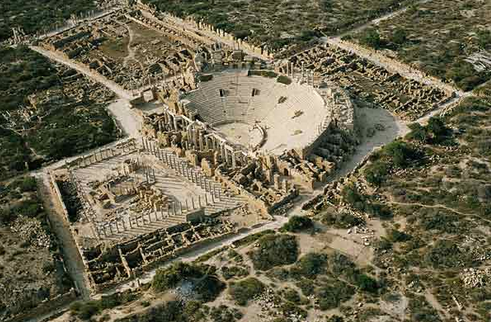
Theatre of Leptis Magna
It had a theatre that was built during the reign of Augustus (27 B.C. – A.D. 14), and one of the most flourishing North African markets of its day. In Leptis Magna, you could buy slaves, exotic animals, olive oil from the rich estates that surrounded the city, garum (Romans’ favourite fish sauce), salted fish, ivory, precious gems, spices, etc. etc. etc.
There was also a forum, the heart of every city, which had a curia, a basilica, a Temple of Liber Pater, a Temple of Hercules, and a Temple of Rome and Augustus.
Finally, what’s a Roman city without a bath complex? In A.D. 126, on his tour of the Empire, Emperor Hadrian had a huge bath complex with a palaestra (exercise field or hall) built for the city. It certainly seemed like the emperors paid attention to this hot, wind-kissed settlement on the south side of the Middle Sea.
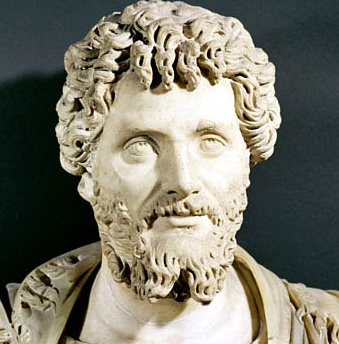
Emperor Septimius Severus
But the real heyday for Leptis Magna came when her own favoured son, Lucius Septimius Severus, became Emperor (A.D. 193-211). It was through this half-Punic (Carthaginian), and half-Roman ruler that the city truly felt the warmth of the sun on its face.
You can read more about the Severus and his family HERE.
Septimius Severus did what most rulers will do for their favourite cities – he gave it infrastructure, and he gave it beauty. Give a city these two things and it will attract population, trade, and the Empire’s attention.
Around A.D. 203 the imperial family and court descended on Leptis Magna; the Emperor had returned home and there were festivals, banquets, and the unveiling or dedication of monuments.

The Severan Basilica
The ruins that have been uncovered in Leptis Magna reveal an ancient city that was wealthy, efficient, and enjoying the good life.
Among the things that Severus built in Leptis Magna were a new harbour and docks, complete with a lighthouse, warehouses and a Temple of Jupiter. For a city involved heavily in trade, this was a big bonus.
Leading from the docks to the nymphaeum (a monument, spring, or fountain dedicated to the Nymphs), Severus ordered the building of a long colonnaded street that was sixty-five feet wide.
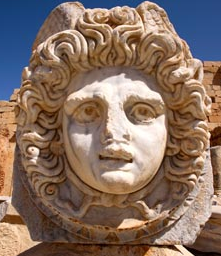
Gorgon head from the Forum of Leptis Magna
He added many new public buildings too, including a large basilica which was decorated with red granite columns with white marble capitals. And even though Leptis Magna already possessed a forum, Severus built a new one that was graced with the enormous Medusa heads that remain to this day.
One of the most interesting pieces of new architecture that appeared in the city during Severus’ reign was the four-sided Arch of Severus. Its design was something new, the friezes and political and religious scenes displaying an artistic style that had not been seen before.
It must have felt like a true ‘Golden Age’ to the citizens of Leptis Magna.

The four-sided arch of Severus at Leptis Magna
You can imagine the palpable excitement among the people in the streets as the Emperor, Empress and their sons disembarked from their ship in the harbour and processed to their palace. The entourage would have been enormous, as well as the force of Praetorians who would have followed the Emperor. After all, Gaius Fulvius Plautianus, Prefect of the Praetorian Guard, was also a son of Leptis Magna.
It is in the midst of all this excitement, among all these powerful and wealthy people, that Lucius Metellus Anguis’ journey in Killing the Hydra begins.
There is a lot going on in the world, and many dangers lurking in the shadows about Lucius.
He will have to tread very carefully indeed…
Thank you for reading!
In the meantime, here are a few more stunning photos of the magnificent artwork discovered at Leptis Magna:

Libyan and Italian archaeologists uncover chariot race mosaic at Roman villa (National Geographic)

An magnificent array of more Leptis Magna mosaics
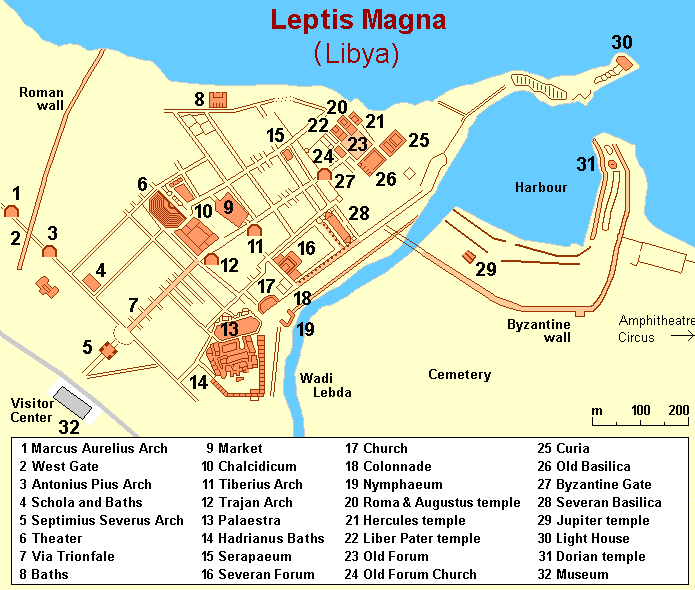
Site map of Leptis Magna (Wikimedia Commons)
Part II – Prostitution in the Roman Empire
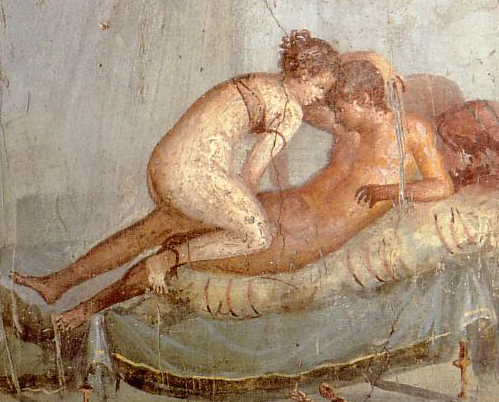
We’re going to a different sort of place in this instalment of The World of Killing the Hydra.
In Part I, we explored the beauty of Leptis Magna which is where the book begins, and which was also the home of Emperor Septimius Severus.
But the Roman Empire was not all about beautiful monuments, lavish banquets, and the adoration of the people for the ruler of the time.
In fact, the Roman Empire had its own maze of back streets and alleyways where life was seedier, and more visceral. It wasn’t all polished marble, but rather slick brick and stinking cells.
WARNING: This post is not suitable for readers under 18 years of age. Also, if you are easily offended, some of the pictures of Pompeian frescoes in this post might be a bit too saucy for you. Just a word of warning for the innocent-minded.
We’re going to take a very brief look today at prostitutes and brothels in the Roman Empire.
Now, if you’re suddenly hoping that Killing the Hydra is my attempt at historical erotica, well, you’re looking in the wrong place. The book is not an orgy extravaganza. If you want that, check out the film Caligula with Malcolm McDowell in the title role.
However, you can’t really write about the Roman world without touching on the long-standing role that prostitution and brothels had to play in society.
They existed, and they most certainly flourished. People of all classes, mostly men, made it a normal practice to visit their favourite brothel from time to time.
If you liked the HBO show ROME, you might have an image of Titus Pullo whoring his way through the Subura with his jug of wine in hand. Certainly, this sort of behaviour was not uncommon, especially for troops fresh back from the wars and looking for a good time.
The flip side might be the richer, upper class nobility who may have believed visiting prostitutes was fine, as long as it was done in moderation and didn’t cause a scandal.
The prostitution scene in the Empire was as large and varied as the workers and clients who kept it running. There was something for everyone!
But let’s look at things a bit more closely.
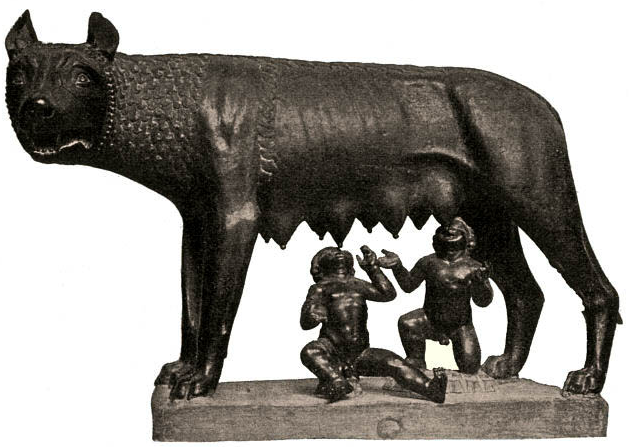
The She-Wolf, or ‘lupa’, suckling Romulus and Remus
One could say that prostitution has ties to the founding of Rome itself.
You may have read about Romulus and Remus, the brothers who founded Rome and were suckled by the She Wolf, or Lupa.
We have heard of lost children being raised by wolves before, but in the instance of Romulus and Remus, many believe that they were actually raised by a prostitute who found them on the banks of the Tiber. The slang word for prostitute in Latin was lupa.
And the word for brothel was in fact lupanar or lupanarium.
Clients were drawn in by the sexual allure of displayed ‘wares’, sometimes lined up naked on the curbside, and the various experiences to be had within. The latter were sometimes illustrated in frescoes or mosaics on the walls of the lupanar. These were intended to add to the atmosphere, or were a sort of menu of pleasures to be had.
There were of course ‘high-class’ prostitutes who catered to wealthy and powerful patrons, women who were skilled at conversation, music and poetry. These high end lupae provided an escape, or a feast with friends, in lavish surroundings coupled with a sort of blissful oblivion. Some might have been purchased by their wealthy clients to keep for themselves, and if that was the case they might have ‘enjoyed’ a relatively easy life compared to the alternative.
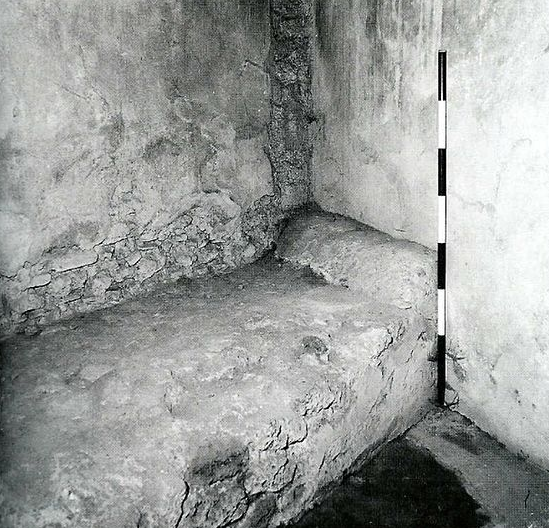
A lupa’s ‘office’ – a cement bed
The truth for most, however, was that they were slaves. And slaves in ancient Rome, as we all know, were objects, property to be used and disposed of on a whim.
Prostitutes – women, men, boys, girls, eunuchs etc. – were at the bottom of the social scale, along with actors and gladiators. They could be adored by clients one moment, and shunned the next. And if a lupa was no longer profitable, the leno (pimp), or the lena (madam) might sell them off as a liability, sending them to a life that was possibly even worse.
In ancient Rome, prostitution was legal and licensed, and it was normal for men of any social rank to enjoy the range of pleasures that were on offer. Every budget and taste was catered to, and because of Rome’s conquests, and the length and breadth of the Roman Empire in the early 3rd century, there would have been slaves of every nationality and colour. Clients of the lupanar would have had their choice of Egyptians, Parthians and Numidians, Germans, Britons, slaves from the far East and anywhere else, including Italians.
However, even though prostitution was regulated, don’t kid yourselves. This was not a question of morality, or curbing venereal diseases. This was about maximizing profit – prostitution was also taxed!
In Pompeii, prostitution became a sort of tourist trade. On the street pavement you just had to follow the phalluses to find the nearest brothel! There were something like thirty-five brothels in the town, and that’s not counting the small curbside cells or niches where the cheapest lupae provided quickies to passers-by.
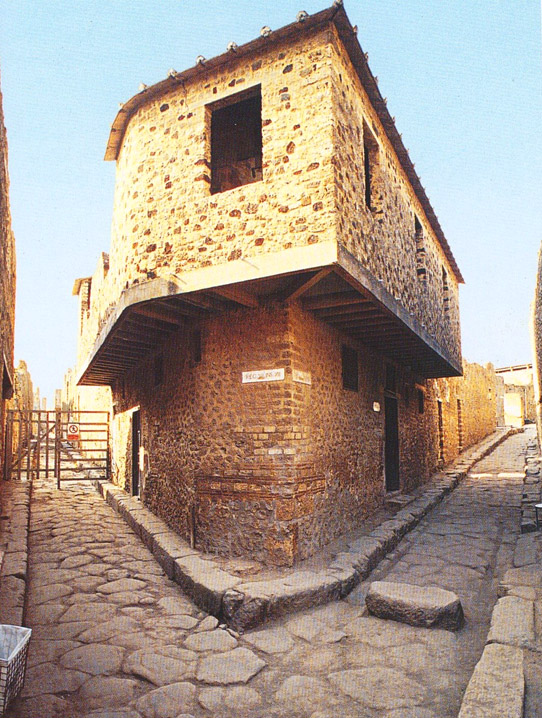
The Great Lupanar of Pompeii
The biggest brothel in Pompeii however, was the ‘Great Lupanar’ located at a crossroads two blocks from the Forum. Many of the frescoes pictured here are from that building which had ten rooms, where most lupanars had just a few.
But we’ve only been looking at prostitution and brothels in Rome and Pompeii. What would they have been like on the fringes of the Empire?
In Killing the Hydra, Lucius finds himself alone and in trouble in the Numidian town of Thugga. This is where he meets one of the secondary characters of the book, Dido.
Dido is a Punic girl who has lost her family and is all alone in the world. She is beautiful, and kind-hearted. But in a world where people were desperate to survive, those who didn’t have protection had few choices. For a young beautiful Punic girl on the North Africa frontier, there would not have been many places that offered a roof, a bed, food and clothing.
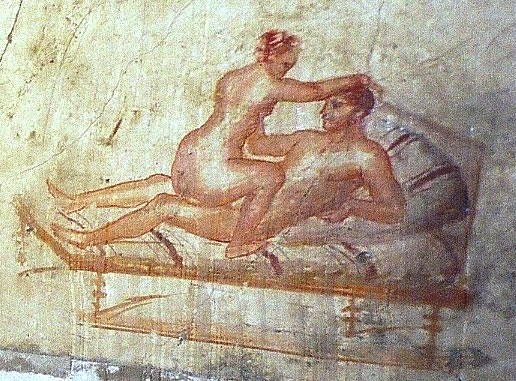
Wall painting from Pompeii
Dido is a prostitute in the Thugga brothel known as the ‘House of the Cyclops’, and she spots Lucius, a young, good-looking Roman walking by – a sure bet in her eyes, and perhaps better than her usual clientele.
But she doesn’t know Lucius yet. He’s not the average man out for a good time. He has much more pressing issues on his mind as he walks the streets of Thugga.
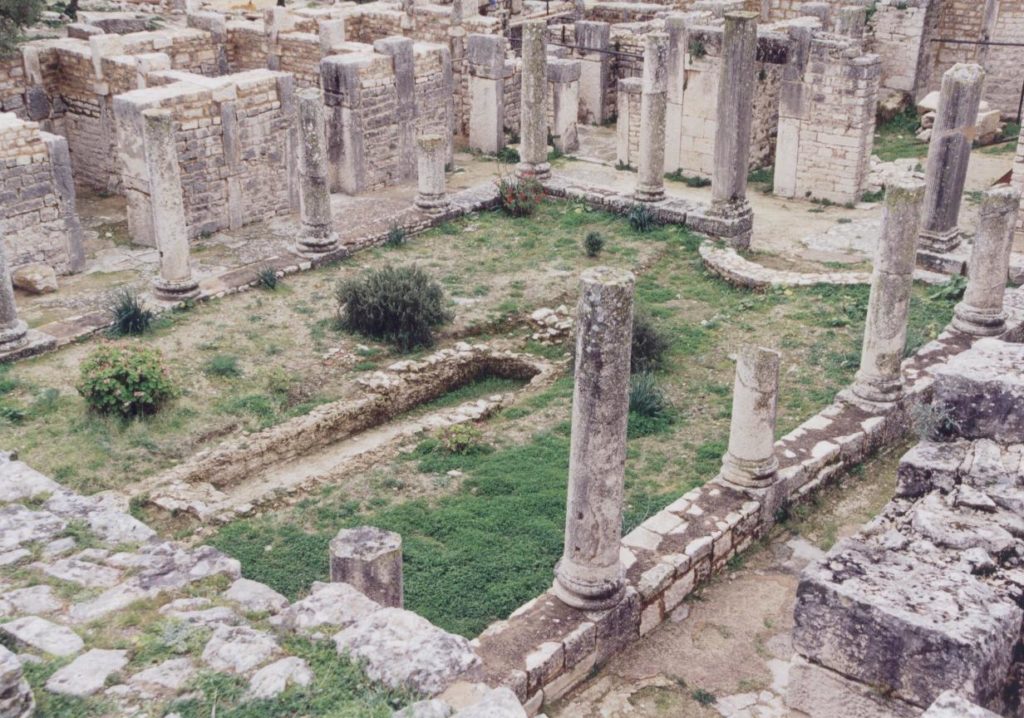
The ‘House of the Cyclops’ in Thugga, modern Tunisia
When I was doing my research for Killing the Hydra in Thugga (in central Tunisia), Lucius and Dido’s meeting played out in my mind as if they were walking alongside me.
Without giving too much away, Lucius ends up needing this young lupa’s help because he has no one else he can trust.
Can he trust this unknown, Punic girl? Will he go into the lupanar and seek her behind the curtain of her tiny cubiculum?
You have to read the book to find that part out. It is funny how one can find help in the most unexpected places!

Pompeian mural
One might think that the subject of this particular post was rather fun to write, that the images above are titillating. And sure, they are to an extent. I don’t mind a bit of risqué material on occasion. Why not?
But then, I can’t help thinking of the lives that these female and male prostitutes had to endure. Very few enjoyed the favour of kind wealthy clients, living in luxurious surroundings.
Prostitutes were slaves and most were probably pumped and beaten for a bronze coin or two before having to receive their next tormentor. These people were objects to the rest of the world, not human beings. They were people’s daughters and sons, mothers, fathers, sisters and brothers. In many cases they’d been taken from their homes on the other side of the world. Perhaps they were all that was left of their family?
For most prostitutes in the Roman Empire, life was a living Hades – just something to remember when looking at this aspect of the larger world of Killing the Hydra.
If you are interested in learning more about prostitution in the Roman Empire, the video below is an excellent documentary that will give you an inside look at the Great Lupanar of Pompeii.
https://youtu.be/5uHuFYYO4go
Part III – Thugga: Walking through a Roman Ghost Town
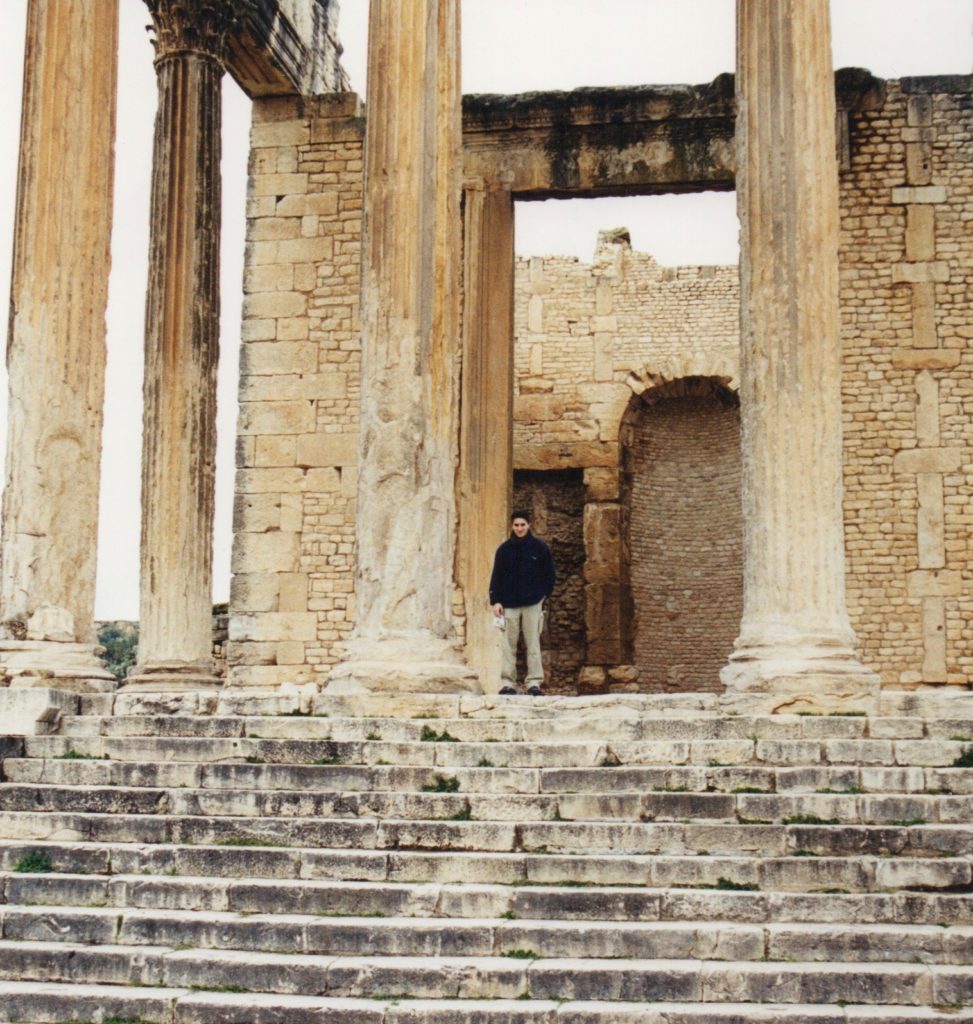
We’re heading back into the province of Africa Proconsularis this week with a brief look at one of the best preserved ‘small towns’ of Roman North Africa – Thugga.
I visited Thugga (also spelled ‘Dougga’) a few years ago, when I was doing research in Tunisia for Children of Apollo and Killing the Hydra.
I was with a small group that headed out in two 4x4s from the ruins of Carthage, south to Thysdrus (El Jem), across the great salt plains of Chott El Jerid and into the soft, sand-seas of the Sahara.

Morning in the Sahara
When we turned north again, skirting the edge of the guarded Algerian border, we came once more into the lush plains of northern Tunisia where grey mountains sprout from green, olive-dotted valley floors, and where low clouds hovered comfortably around their peaks in what was the mildest January I’ve ever experienced.
The countryside was beautiful and lonely, and I missed the desert dunes very much by that point, our time in the South having been all-too-short.
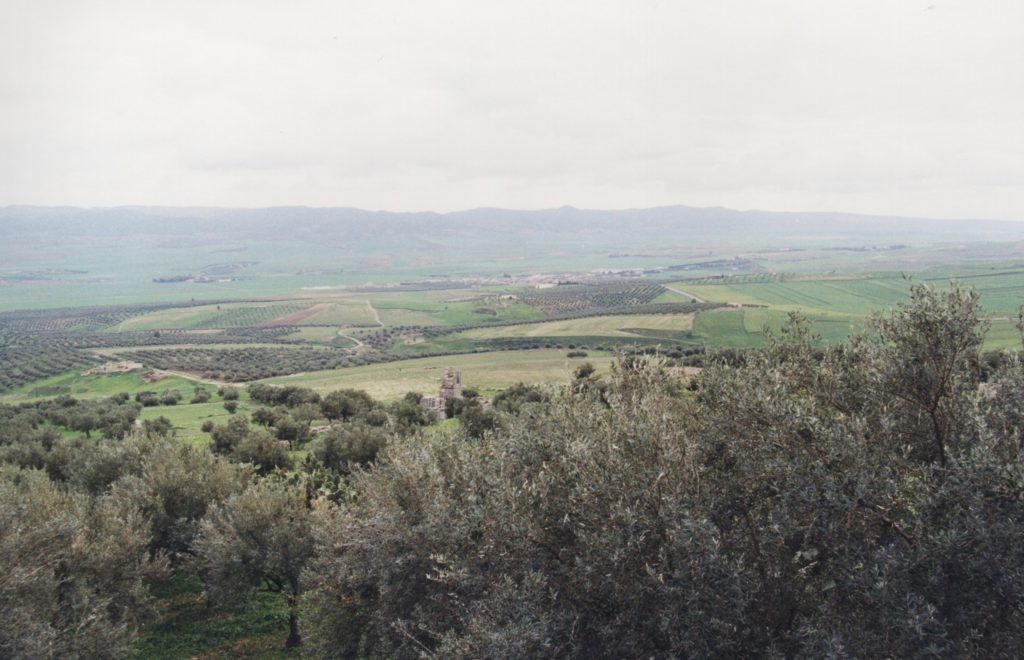
Countryside of Northern Tunisia
Admittedly, I had not heard of our next destination, ‘the place of Dougga’ as our guide called it. Our truck pounded along the winding, potted roads, climbing higher and higher, the land getting greener by the mile.
I also had a fever at this point in the journey, the result of having opted for what I thought was boiled soup, rather than camel meat a couple nights before.
Quick tip: they don’t boil the soup, and eating it is equivalent to drinking a murky glass of Saharan tap water.
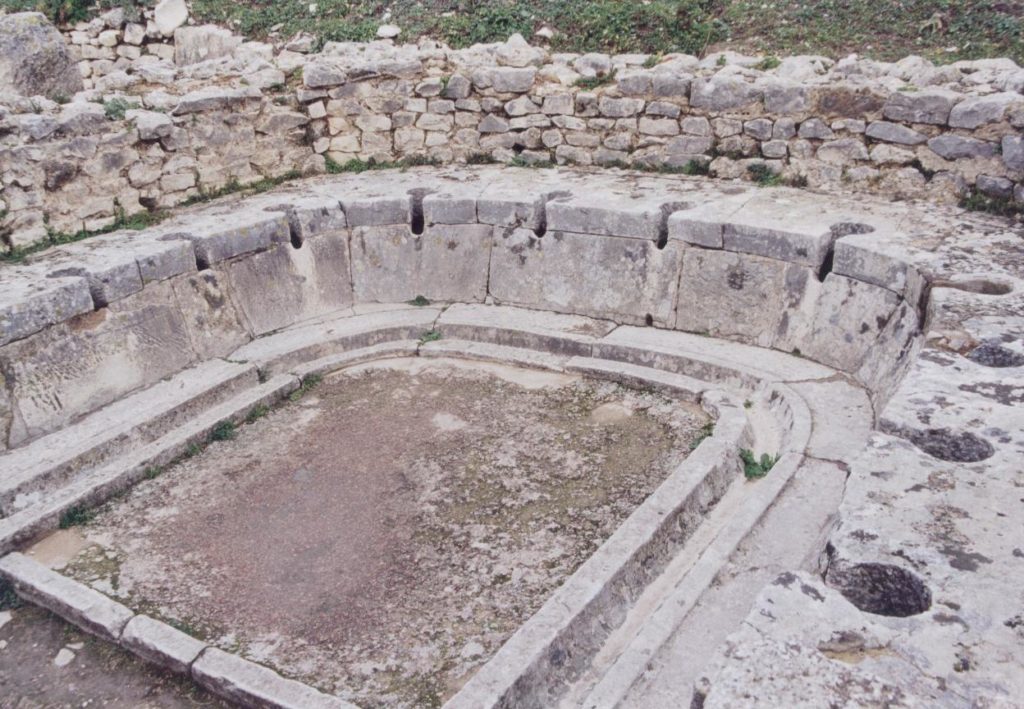
A public latrine in Thugga
Nevertheless, the historian in me could not help but spot the distant ruins perched on a hillside in the distance. As we came closer, and the road got rougher, it became apparent that there was much more to ‘the place of Dougga’ than we had been led to believe.

The sprawling remains of Thugga
This wasn’t a small gathering of weathered ruins – it was a city! Or rather, it felt as such in that lonely, windswept place.
I stepped out of the truck, grateful that the ‘Couscous Beats’ soundtrack our driver had been torturing us with since the beginning of the trip finally stopped. Everything was quiet, but for the wind, and the crunch of gravel beneath our feet as we approached the small, shuttered kiosk.
When I saw no one was there, I wondered if we would be able to get in, and craned my neck to try and see the tantalizing view beyond the gates.
From the side came a man with a shot gun slung over his shoulder. We had just woken him from his obviously important duty. He smiled however, and spoke in hushed tones with our guide who evidently knew the man, or appeared to know him.
Our man turned to us and nodded. “You have one hour,” he said, and the gates opened.
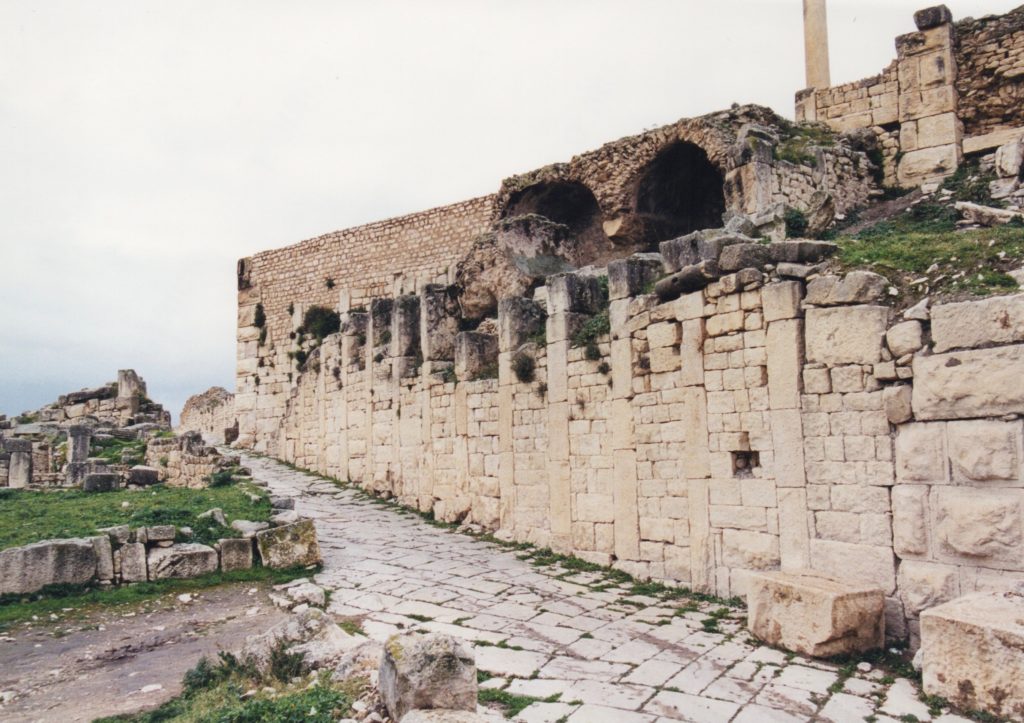
One of the main streets of Thugga
I’m not going to go into the history of Thugga a great deal here – there is an uncharacteristically good Wikipedia page on this site which you can read by CLICKING HERE.
But, before we walk the streets of this Roman ghost town, there are a few things worth mentioning.
Thugga has had a long a varied history of settlement, having gone from its origins as a Numidian-Berber settlement, to a place under Punic control during the ages of Carthaginian hegemony, to a major Roman town, and finally under Byzantine control prior to Arab dominance in the region.
In the first century B.C., the Greek historian, Diodorus Siculus mentioned the “beautiful enormity” of Thugga.
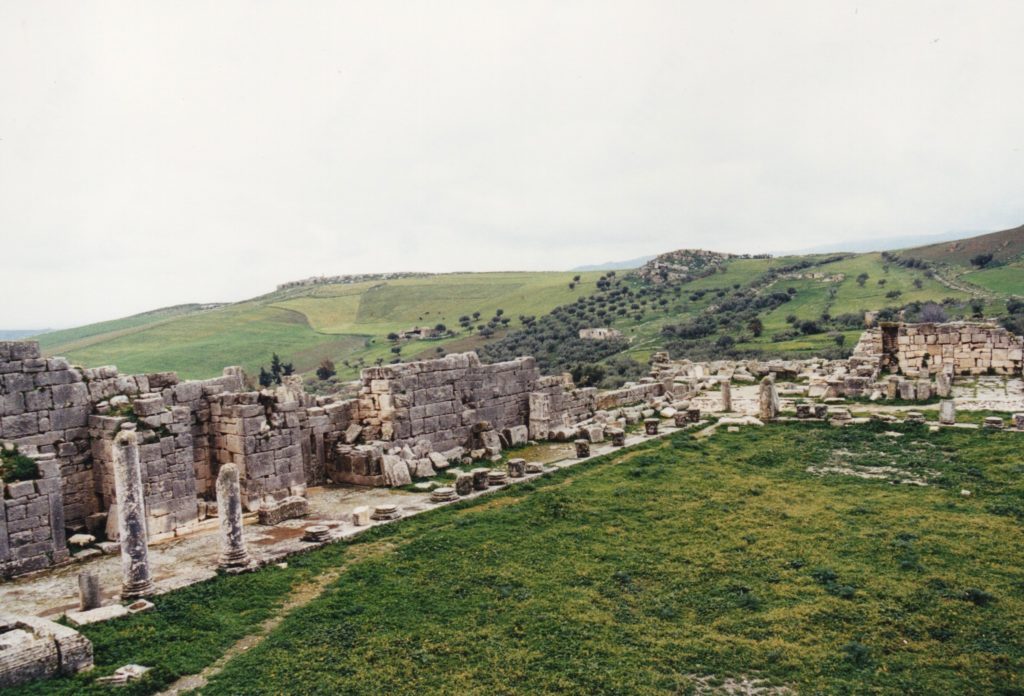
The Forum of Thugga
It is a big site – about sixty-five hectares (about 161 acres) – which makes it surprising that Thugga is considered a ‘small’ Roman town. Its population when it was at its most prosperous in the 2nd and 3rd centuries A.D. is said to have been about five thousand residents.
UNESCO made it a World Heritage Site in 1997, and cited it as the “best preserved Roman small town in North Africa”.
Thugga was a thriving settlement because of agriculture, its location on the fields of northern Tunisia ideal for crops. But its fortunes took an even better turn in A.D. 205 when it was made a municipium by order of Septimius Severus and his son, Caracalla, acquiring the title of Municipium Septimium Aurelium Liberum Thugga. After that, Thugga received more rights and freedoms, and magistrates of the town were made Roman citizens.
Thugga didn’t enjoy the imperial favour that Severus’ hometown of Leptis Magna did, but it did prosper under Severus, aided by the fertile landscape that surrounded it, olives, oil, and grain being key to the running of the Empire.
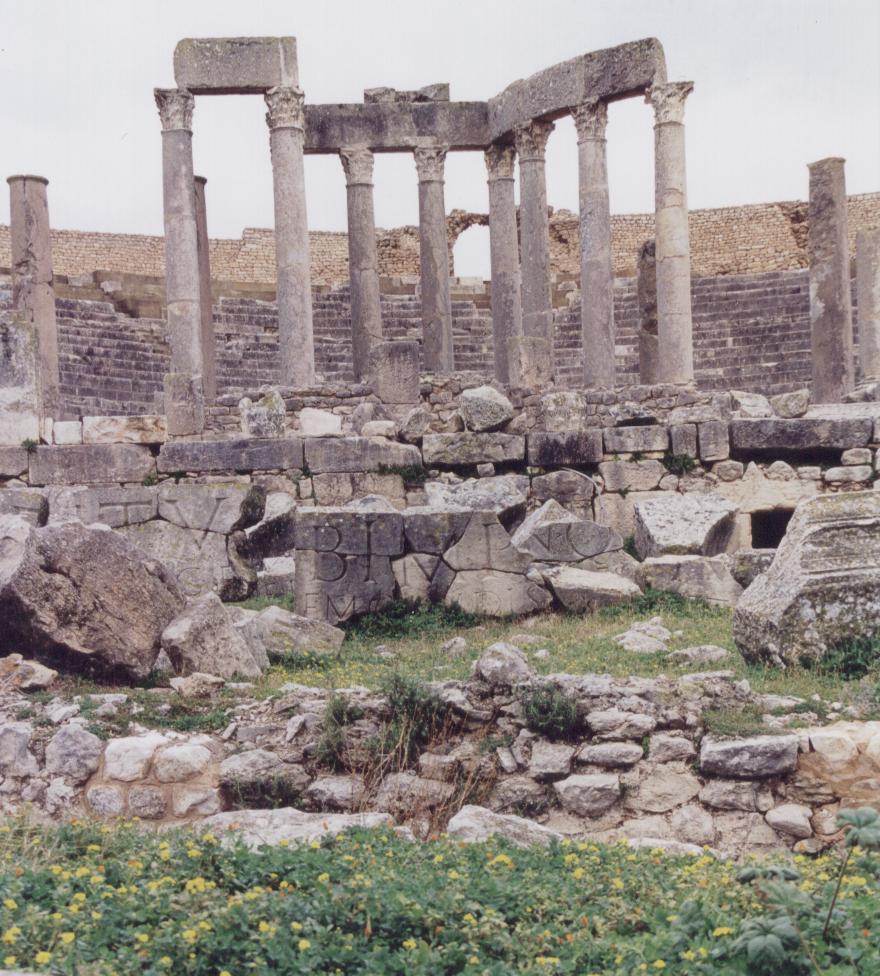
Theatre of Thugga
I didn’t know any of this however, as I stepped through the gate of the archaeological site and entered the labyrinthine streets of Thugga as our guide settled himself beneath an olive tree and left us to our own devices.
One hour was not nearly enough time!
Our small group quickly broke apart as people set about exploring the site with confidence, as if they were walkers in some sort of past-life recollection, certain of where they needed to go.
For myself and my friend, it was more a feeling of overwhelm that snared us. The streets stretched out before us in great slabs of polished white and grey stone. We didn’t know where to start, so we headed in the direction of the biggest monument near the entrance – the theatre.
The theatre of Thugga is incredibly intact, and as we climbed the concentric rows of seating to the top, the picture of Thugga became much more clear as it spread out before us.
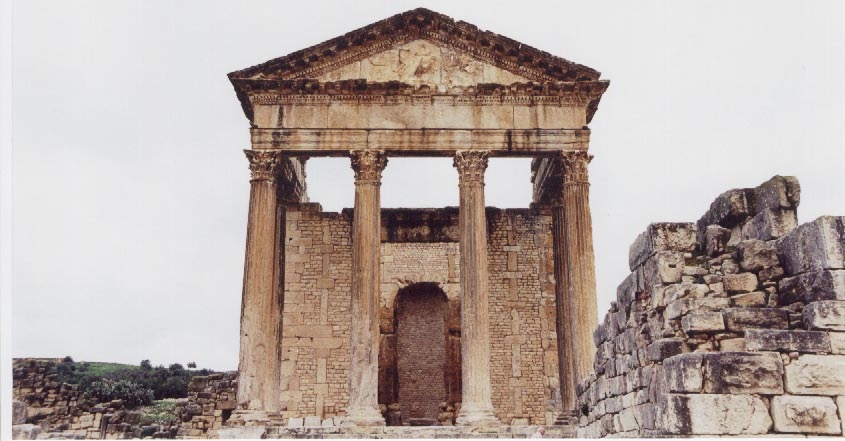
The Capitol of Thugga – the Temple of Jupiter, Juno, and Minerva
From the top row of the theatre I could see the high part of the town with the capitolium and agora beside it, the market place, the curve of one of the main streets passing the baths and going farther down into the residential part of ancient Thugga.
Five thousand residents may not seem like many, but when you look at a sprawling site like this, so quiet and complex, you begin to hear the voices of the past in a way that makes visiting an isolated archaeological site a truly unique experience.
To me, Thugga is a place of ghosts.
At every turn, I felt like I was intruding upon someone – a priest sacrificing in the Temple of Jupiter, Juno and Minerva, a slave buying supplies in the marketplace, a couple of locals discussing business in the agora, or two ladies whispering in hushed tones in the baths where they stand upon the black and white geometric mosaic floor that was open to the sky. From the marble-framed doorway of a private domus, a mother watches me pass while her child plays on the stoop at her feet… It was the same, everywhere we went.
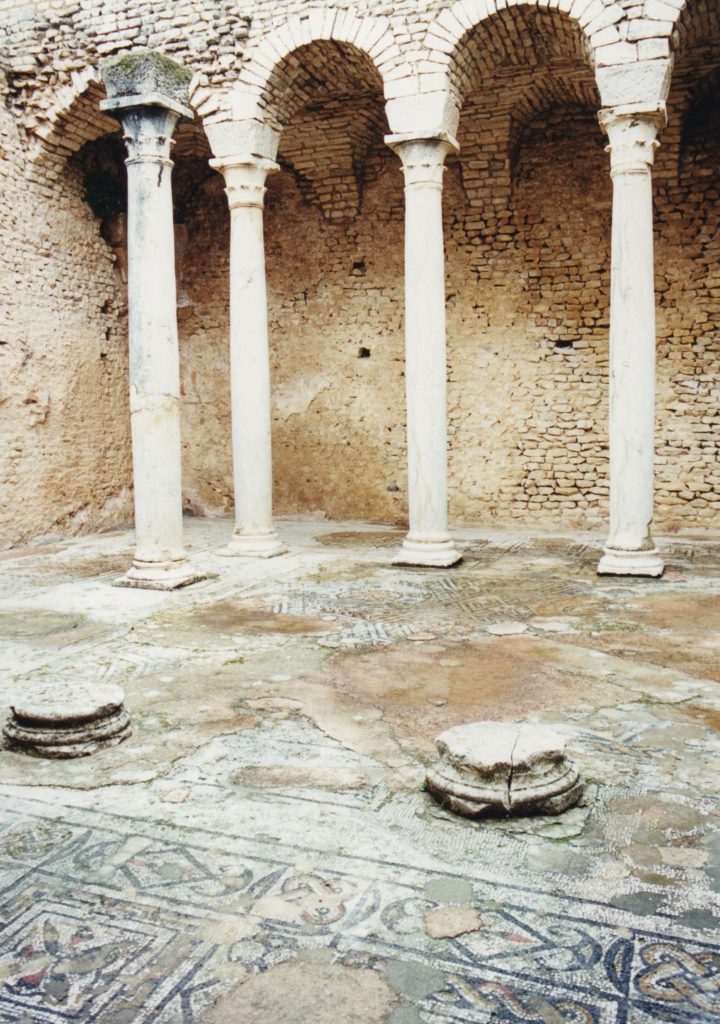
Inside one of the public baths, mosaics open to the sky!
As we walked around, the voices Thugga’s residents became louder in my ears, their shades passing around me as they went about their daily business.
I was blown away by the fact that this almost completely intact city was just sitting there, deserted, its mosaics open to the sky.
Even more shocking was that as I walked around, the seeds of my story began to take shape in my mind. I saw Lucius walking through these very streets, visiting the temple, the marketplace, being pursued by local thugs.
What I didn’t see was the young prostitute who would approach him on that very street I was walking on, and how she would be the only person who could help him in a time of need.
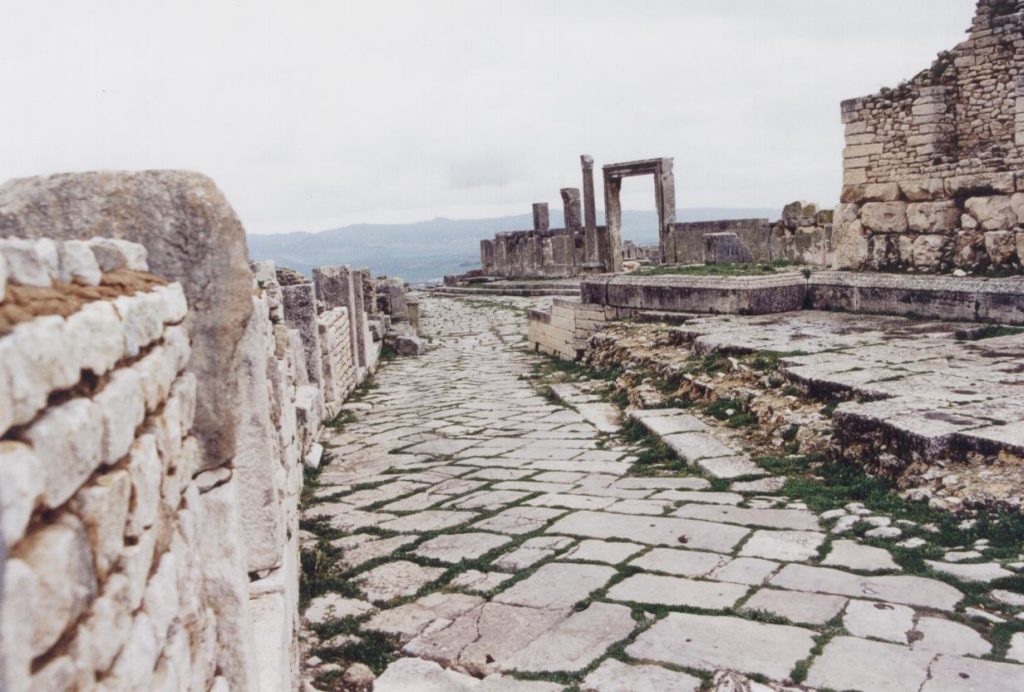
Wandering with the ghosts of Thugga down the main street
As a writer, it’s a magnificent experience to have your story take shape like that. I didn’t realize it fully at the time as I stepped into the ruins of the brothel, or the public latrine, following the road down toward the second century B.C. Libyan-Punic mausoleum to look out over the valley.
As I stood there, our short, almost cruel, hour hard upon us, I can’t recall hearing any birdsong, tractors in neighbouring fields, or distant cars.
What sticks with me from my time in Thugga, apart from the wondrous physical remains, is the sound of the wind and the ghostly whispers of its citizens in my ears.
It really is one of the most amazing places I have ever travelled to, and the fact that it was deserted was a gift.
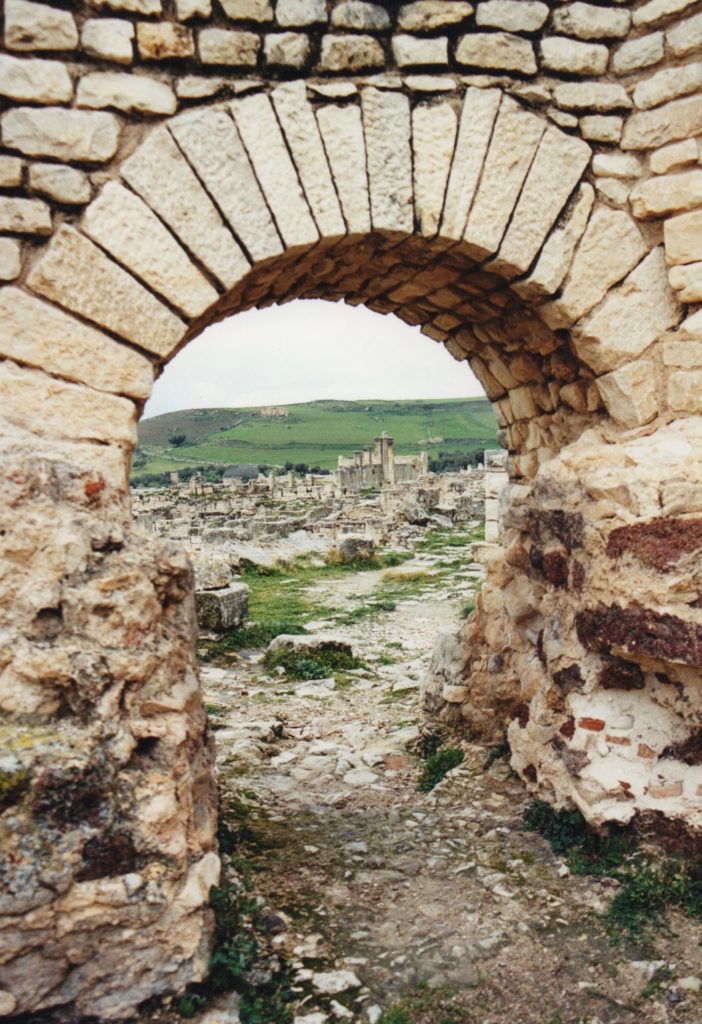
View of the lower town from the baths
Reluctantly, I climbed back into the 4×4, my fever quite forgotten for the past hour, and the engine erupted, intruding on my reverie, drowning out the voices and the wind.
As we drove away from this ancient ‘small town’, I thought about how much that trip was a journey of discovery and inspiration, and how it helped me to realize that the Roman Empire was much more vast than I had ever imagined.
I knew I would go back to Thugga, but next time, it would be on the pages of my book.
Part IV – Horse Warriors: The Sarmatians
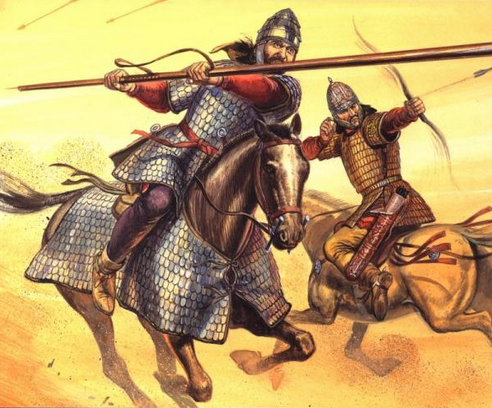
Artist impression of Sarmatian Cavalry
In this fourth installment of The World of Killing the Hydra, we’re going to look at a group of warriors who also have ties to myth, and who, as a fighting force, became legendary in the Roman world.
We are, of course, going to talk about the Sarmatians.
In Killing the Hydra, Lucius Metellus Anguis finds himself getting to know the men of the cavalry ala of Sarmatians who have been sent to join the III Augustan Legion at Lambaesis, in Numidia.
The leader of this fighting force is Mar, a king of his people who led them against Rome in the wars with Emperor Marcus Aurelius. Mar is joined by his royal nephew, Dagon, and both men play a key part in the story.
But who were the Sarmatians?
The average person has not heard about this group of warriors that came to form the elite heavy cavalry of the Roman Empire. Most people probably know of them only from the role they play in the movie King Arthur, with Clive Owen.
Researching Sarmatian warrior culture was a fascinating part of the research for Killing the Hydra.
The Sarmatians were a Scythian-speaking people from north of the Black Sea, and the high point of their civilization spanned from the 5th B.C. to the 4th century A.D. when they eventually went into decline because of pressure from the Huns and Goths.

Lance head of a Sarmatian ‘contos’, a 16 foot lance
The Sarmatians were a nomadic Steppe culture whose lands extended from the Black Sea to beyond the Volga in western Scythia.
Herodotus believed the Sarmatians (or ‘Sauromatae’) were descended from intermarriage between Scythian men and Amazon women, and that ever since the two peoples joined:
“the women of the Sauromatae have kept their old ways, riding to the hunt on horseback sometimes with, sometimes without, their men, taking part in war and wearing the same sort of clothes as men… They have a marriage law which forbids a girl to marry until she has killed an enemy in battle; some of their women, unable to fulfill this condition, grow old and die unmarried.”
(Herodotus, The Histories, Book IV)
Indeed Sarmatian grave discoveries have revealed armed women warriors, so it seems likely that such tales would easily have given rise to the Greek perception that the Sarmatians were descended from the Amazons, those beautiful and terrible daughters of Ares.
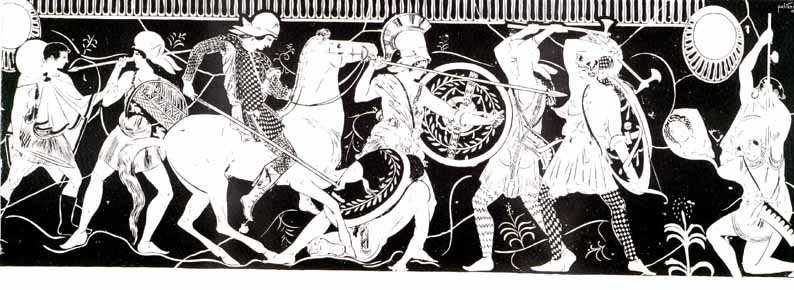
Amazons in battle
In Killing the Hydra, Mar, in conversation with Lucius, relates to the young Roman how the women of their people also fought:
“The women of our land are brave souls. We do not lock them up before the hearths of our homes. They are free to ride with us and wield the sacred sword. Some are priestesses and others have been gifted by our gods with foresight. Sarmatian women are nobler than what your Latin word ‘noble’ implies.”
(Mar, in Killing the Hydra)
And what of the men? Sarmatian men were fierce warriors and skilled horsemen, and according to the Roman writer Ammianus Marcellinus, they:
“…have very long spears and cuirasses made from smooth and polished pieces of horn, fastened like scales to linen shirts; most of their horses are made serviceable by gelding, in order that they may not at sight of mares become excited and run away, or when in ambush become unruly and betray their riders by loud neighing. And they run over very great distances, pursuing others or themselves turning their backs, being mounted on swift and obedient horses and leading one, or sometimes even two, to the end that an exchange may keep up the strength of their mounts and that their freshness may be renewed by alternate periods of rest.” (Ammianus Marcelinus, Roman History, Book XVII)
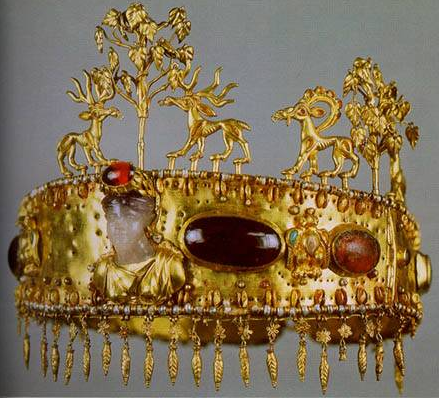
A Sarmatian crown
Sarmatian art and culture is also very rich.
Animal imagery was common in their artwork and often included such totem animals as dragons, griffins, eagles, sphinxes, snake women, and of course, horses. Often, these images were tattooed on their bodies.
The characters of Mar and Dagon are naturally curious about the dragon imagery on Lucius’ armour and weapons. They see it as a sign.
Also, if you remember the Sibyl’s prophecy from Children of Apollo, you will know that Lucius’ meeting with the Sarmatians is no coincidence.
The Sarmatians take their gods very seriously, but the one they most revered was their war god who was represented by the Sacred Sword.
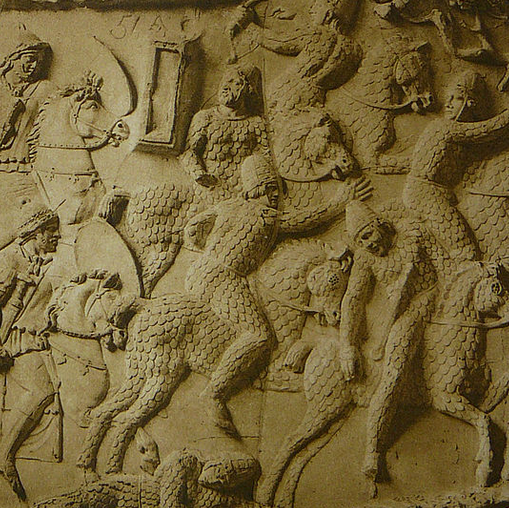
Sarmatian Warriors on
Trajan’s Column
The Sarmatians’ favourite trial of strength was single combat.
They believed that there was mystical power in battle, and when they defeated their enemies, it’s said they often took the heads, scalps, and beards of the vanquished, drinking blood from the skulls of the slain.
Ancient cultures often did have what we might perceive as barbaric rituals, but it’s sometimes difficult to detect truth in the midst of Greek and Roman propaganda or storytelling.
The picture painted does make for a wonderfully colourful group of warriors.
Despite the tales of fighting women, magic swords, scalping, and the drinking of blood, there is one fact that remains certain – the Sarmatians were some of the best cavalry the world had ever seen.
They were sometimes known as ‘lizard people’ because of their scale armour which covered both the horse and rider almost completely.
The Sarmatians were heavy cataphracts, the shock troops that were used to ride down the enemy while wielding their long swords, and the contos, a lance of about five meters, or sixteen feet long.
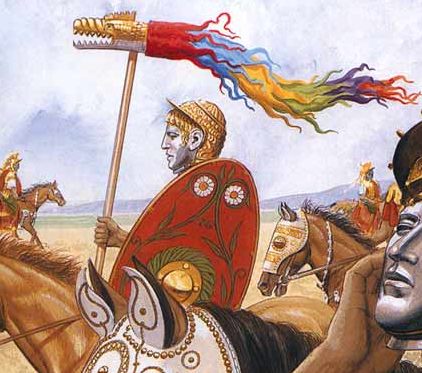
Artist impression of a
Draconarius carrying a Draco
The image that the Sarmatians are probably most known for, however, is the draconarius.
This was their war standard which they carried into battle. It consisted of a bronze dragon’s head with a long wind sock attached to it. It was held on a pole and carried at a gallop. When the wind passed through the draco, it made a loud howling sound that was said to terrify the enemy.
The draco was adopted as a standard by all Roman cavalry in the 3rd century A.D.
It’s amazing that, as a highly disciplined fighting force, the Sarmatians remained active for as long as nine centuries.
When Marcus Aurelius won a decisive victory over the Sarmatians in A.D. 175, he obtained an elite heavy cavalry for Rome that would make the auxiliaries much more of a force to be reckoned with.
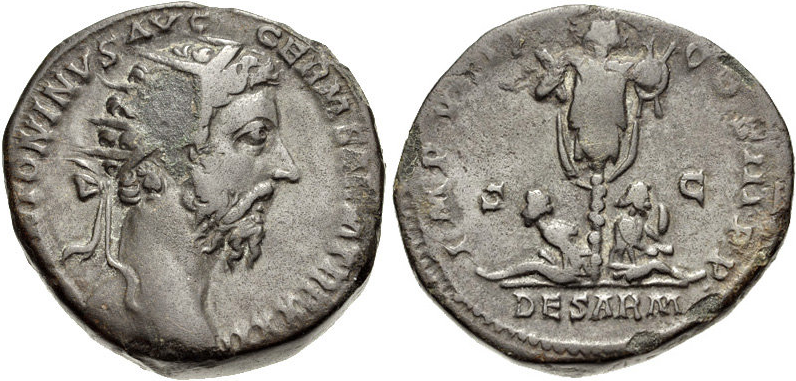
Coin of Marcus Aurelius showing Sarmatian captives
As ever, the Romans knew a good thing when they saw it.
In the aftermath of Rome’s victory, Marcus Aurelius obtained 8000 heavy Sarmatian cataphracts which became the most skilled cavalry of the age.
It is these warriors, descended from the Amazons and mighty Scythians of the Steppes, who now step into The World of Killing the Hydra.
Mar, Dagon, and their warriors turn the tides of war against the nomads in Numidia, and become an important new force in the life of Lucius Metellus Anguis.

Draco standard
The Dragons are now in the thick of it with the Eagles of Rome.
Thank you for reading.
Part V – Desert Legion:
The Fortress of Lambaesis – Imagining Saharan Frontier Life
What was it like to live on the very edge of the Roman Empire?
When writing Killing the Hydra, this was something I asked myself many times. What was life like for soldiers, commanders, women, children, and locals under Roman rule? What was it like to be so isolated in a place that, for many, sat on the precipice of the known world?

In this fifth and final part of The World of Killing the Hydra, we’re going to look at the place where Lucius Metellus Anguis is posted to, and where his family joins him – the legionary base at Lambaesis.
Lambaesis was located in the province of Numidia (modern Algeria), and was the base for the III Augustan legion at the beginning of the third century A.D. when this story takes place. Lambaesis was established by Emperor Hadrian between A.D. 123-129 when the III Augustan legion moved there.
Hadrian toured the Empire and on his visit to Lambaesis, he addressed the troops of this desert legion. Evidence of this address has come down to us in the form of a pillar inscription that was located on the large outdoor parade ground of the base.
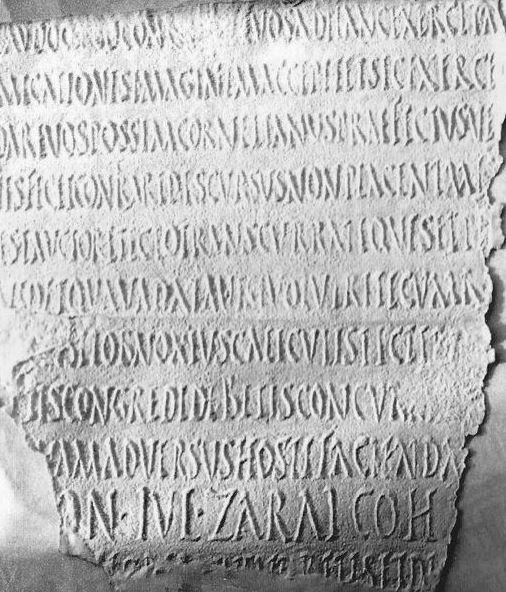
Part of the inscription from Lambaesis documenting Hadrian’s address to the troops when he visited there.
The III Augustan legion, however, was older than that. It originated under Pompey the Great in the civil war against Julius Caesar and was eventually moved to North Africa in 30 B.C. by Octavian (who became Augustus) after his victory over Mark Antony.
Eventually, the III Augustan came to be based at Lambaesis, one of only two Roman legions in North Africa, the other being based in Aegyptus.
The III Augustan played an important role in the security and urbanization of North Africa, helping to build roads, aqueducts, fortifications, theatres and more. This work in turn connected towns and cities, facilitated trade, and provided protection for outlying settlements. The work of the army engineers and surveyors brought Roman civilization to this remote frontier.
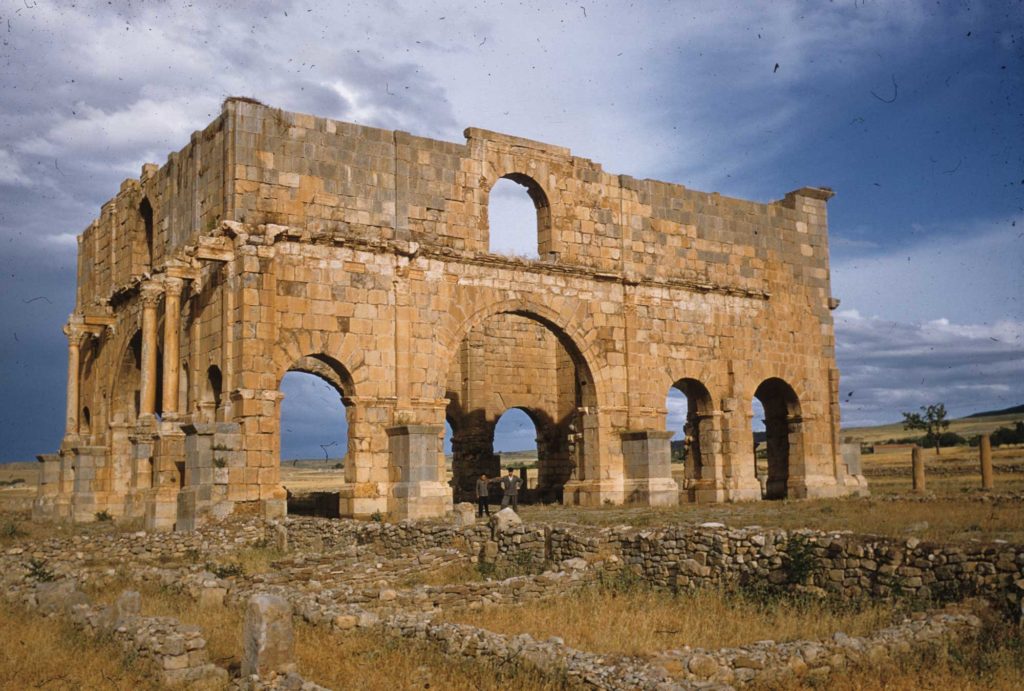
The Praetorium of Lambaesis
The III Augustan was a veteran legion, and of the remains present in that place, apart from the arches of Septimius Severus and Commodus, temples, baths and cemeteries, the principia with its open courtyard is the most stunning of its remains.
This base was on the edge of the deep desert in modern Algeria, backed by the Aures Mountains. At first glance, this seems to have been a lonely windswept place, just as it is today. However, during the Roman period, Lambaesis would have been a busy, thriving place.
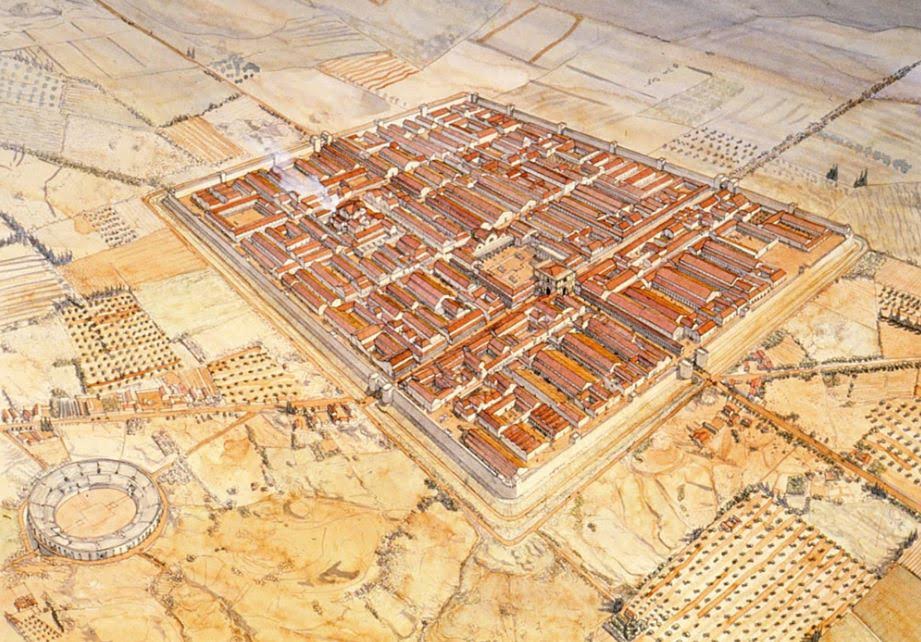
Artist impression of Lambaesis by Jean Claude Golvin
This was not so much an active frontier like that of the Danube or Parthian fronts, but rather a more peaceful place, punctuated with occasional incursions by Garamantians, nomadic Berber tribes and others.
For the most part, the veterans of the III Augustan took part in public building works and improvements, as well as patrols. The men of the legions were a part of society at Lambaesis and the surrounds.
Previously, men of the legions were not permitted to marry, but this law was changed under Septimius Severus, and so many men would have had families living in the vicus outside the base’s walls, or in some instances within the walls.
Add to this the presence of the large, prosperous colonia of Thamugadi, just seventeen miles away, and you have a frontier that was busy, social, and economically vibrant.
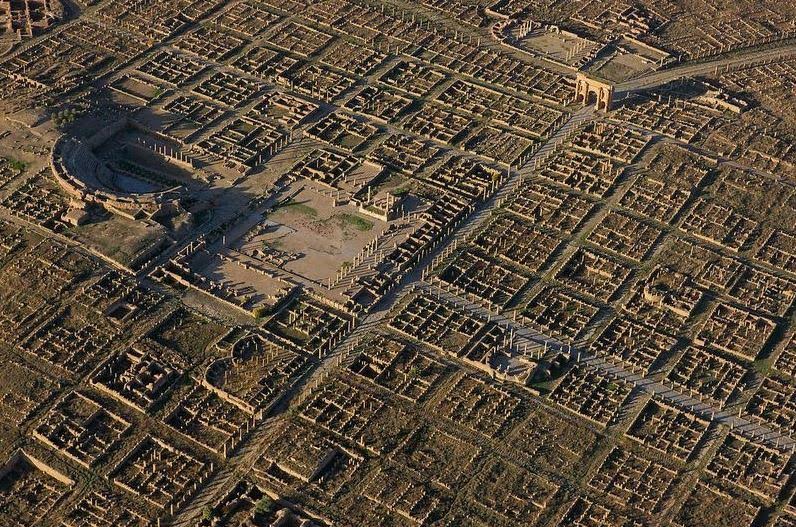
Aerial view of the colonia of Thamugadi
The colonia of Thamugadi was where veterans of the III Augustan legion retired to once their military service was at an end. It was founded by Emperor Trajan in about A.D. 100 under the name of Marciana Traiana Thamugadi. It was a walled settlement, but not fortified, and had a population of about 15,000.
Today, it is made up of some of the most intact and vast ruins of Roman North Africa, including the well-preserved arch of Trajan. It had twelve public baths, theatres, a public library, a basilica and a magnificent temple of Jupiter.
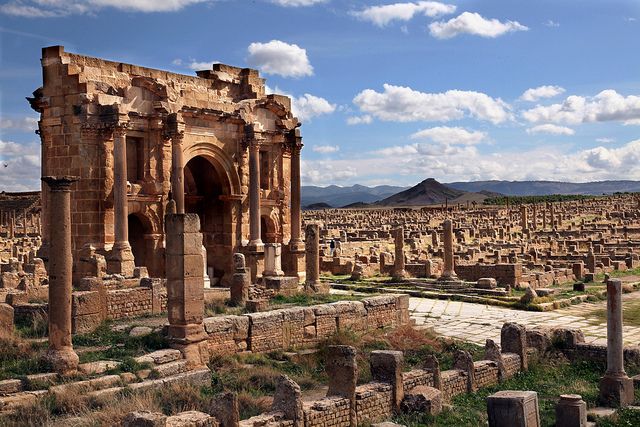
The arch of Trajan in Thamugadi
One imagines that it was lonely for soldiers’ wives and their children, being posted to such a remote location, compared with other parts of the Empire, but with the changed laws regarding marriage for troops, the close proximity of Thamugadi to Lambaesis, and the thriving economy of Roman North Africa at this point in time, it seems like Saharan frontier life may not have been the sort of lonely, wasteland existence that I had in mind when I started my research and writing.
I always try to travel to the places I am writing about, but sometimes that just isn’t possible, or safe. Lambaesis was one of those places.
At the time of my Tunisian research for Children of Apollo and Killing the Hydra, we were told there was a travel ban to Algeria where the remains of both Lambaesis and Thamugadi are located.

Artist impression of Thamugadi by Jean Claude Golvin
Our 4X4 skirted the military border between the two countries, distant guard towers and barbed wire visible as a long grey line cutting across the North African landscape.
We asked our guide if we could drive into Algeria but he was adamant that it wasn’t possible. “No chance. It is forbidden. They will shoot at us,” he said.
I don’t know if that was true or not, but some things are not worth the risk. After all, we have the internet now and a myriad of resources on-line.
So, we had to settle for pulling our truck over on the gravelly roadside and gazing westward across the guarded border to the Aures Mountains of Algeria and imagining what remnants of Rome lay scattered in that vast expanse.
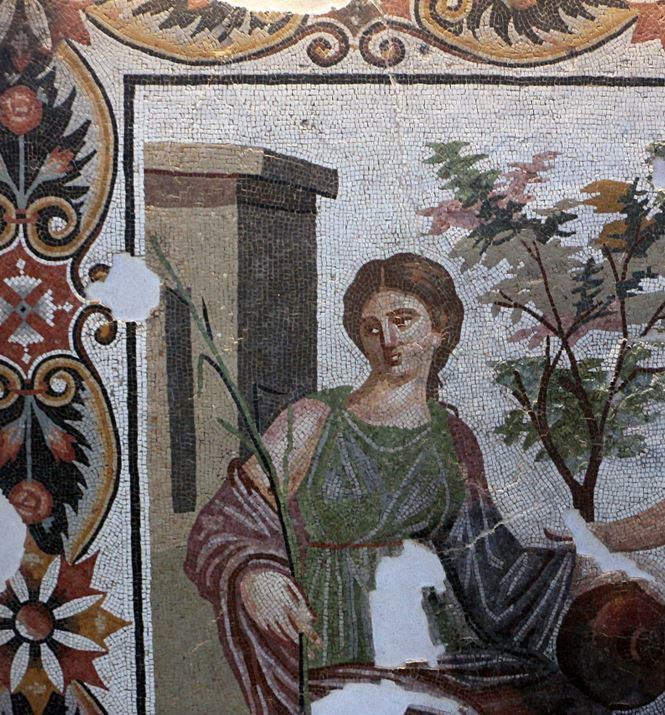
Mosaic fragment from Lambaesis
The light was dull that day, an iron-grey winter sky, so the feeling of loneliness and desolation was acute. Somewhere out there was the base of the veteran III Augustan legion. There was a colonia for veterans filled with the amenities of Roman civilization.
This was a land where my character was to be posted, along with his family, and the families of his fellow officers and troops. Many would have had family and friends in Thamugadi, done business there, and used the network of roads that really did, in one way or another, lead back to Rome…
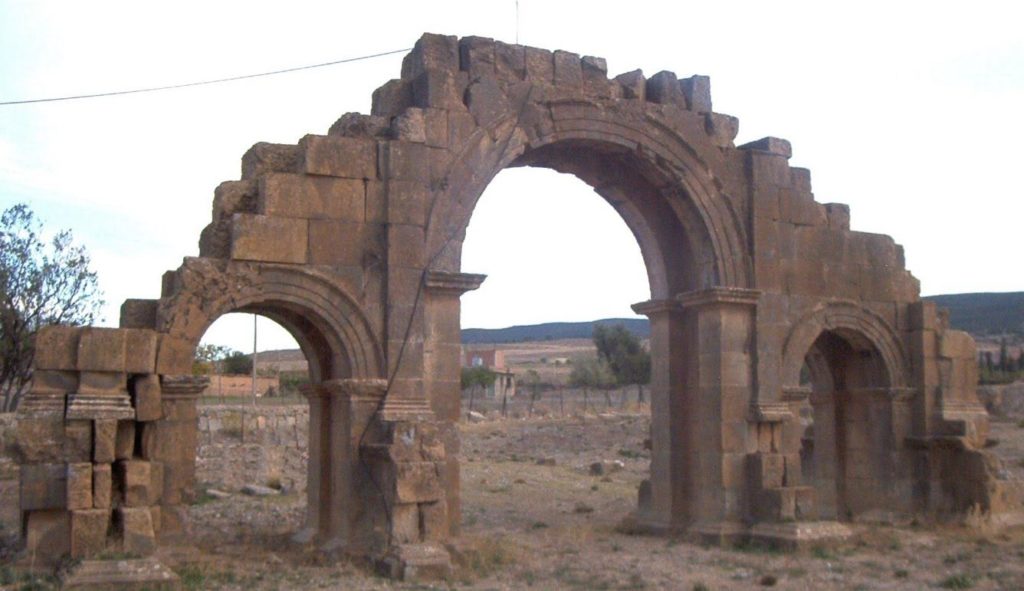
Arch of Septimius Severus at Lambaesis
It was hard to imagine as I stood there with the dust whipping around us, our guide looking nervously in our direction as if we might attempt something stupid.
The relief on his face when we said “OK. Let’s go.” was darkly comic. It was also real.
But maybe that hints at Saharan frontier life in the Roman Empire?
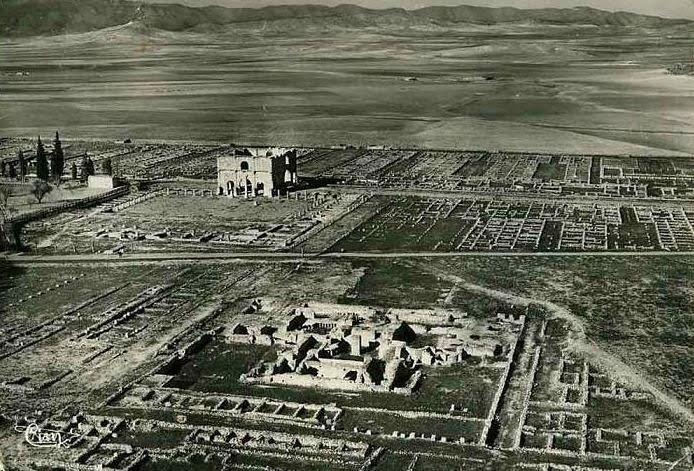
Aerial view of Lambaesis

